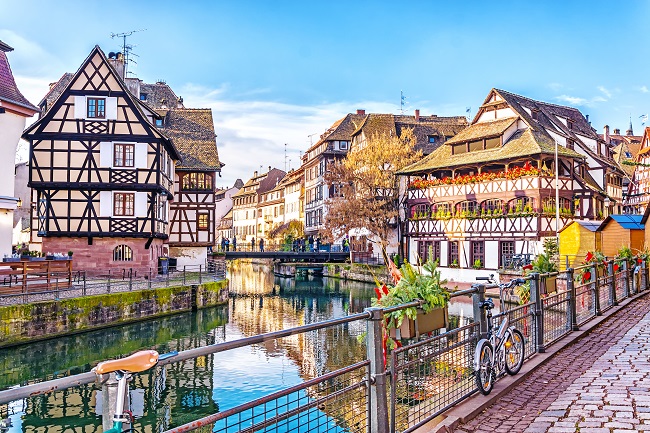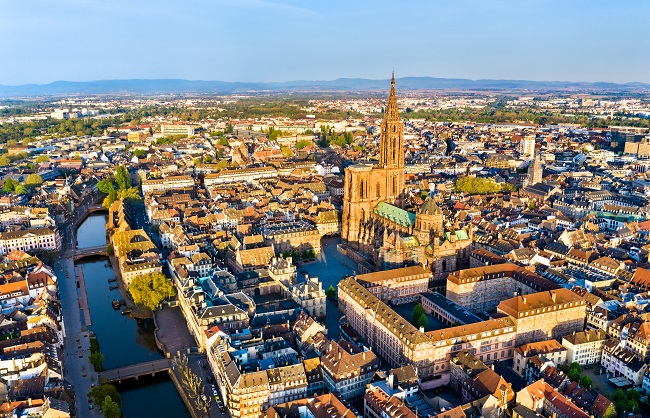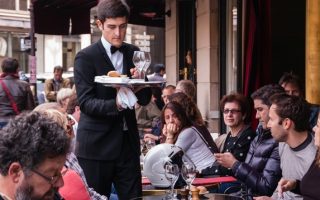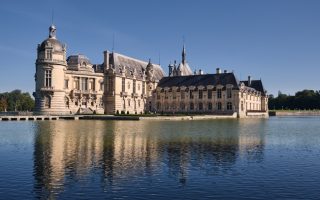Carnet de Voyage: Strasbourg, a French-German Fusion

Travel notes from the real France. Carnet de Voyage is a weekly personal travel story in France sent in by readers. If you’d like to write a story for Carnet de Voyage, head here for details on how to submit.
Fusion of French and German cultures has been at the core of being a Strasbourgeois. That is what a Strasbourgeois would tell you―the cab drivers, merchants, and museum ‘gardiens,’ for instance. They embrace the idea as the way things naturally are.
This blended identity may defy attempts to resolve the question of what it means to be French. The French, probably more than many other Europeans, have been obsessed with a national identity. How has being French changed in contemporary times? The national pride of being uniquely French may be behind certain attempts to keep the language ‘pure’ and their cuisine unalloyed by foreign ethnic influences.
Strasbourg, the largest city in the Alsace region, is only five km (about 3 miles) from the German border where the two countries share use of the Rhine river. Proximity would account for part of that blended identity. But travel, the internet, trade, and international politics have also figuratively shrunk our world. Culture is getting hybridized in most parts of the globe. Words from other languages like ‘weekend,’ ‘super,’ ‘stop,’ are now a part of the French vocabulary, uttered in that accent you might find either lovable or irritating, depending on your attitude to the French. And cilantro, mangos, and other exotic ingredients now commingle with cream and butter in the dishes of French chefs. Fusion, of one sort or another, is ‘in’ everywhere.
Being a Strasbourgeois is a rather remarkable state of being, when you learn that France and Germany had many past animosities and deadly conflicts. Conflicts that have passed Strasbourg several times from one country to the other―for instance, Louis XIV annexed it in the late 17th century, and Hitler repossessed it during World War II. The city’s liberation in 1944 returned Strasbourg to the French.

Strasbourg’s cathedral is one of the tallest in Europe © Leonid Andronov / shutterstock
You see the blended identity of Strasbourg in the artifacts of a culture most obvious to tourists. In timbered buildings, for instance, with their decorated walls and intricately carved posts. Or in dishes like choucroute alsacienne, and flammerkueche (tarte flambée in French) on offer at brasseries, winstubs (wine taverns), and boulangeries. Or in French and German signs on streets and commercial buildings. Many Strasbourgeois speak German in addition to their native French.
The melange that is Strasbourg is what makes it a world class city. Today, it is officially one of the cities that make up a Eurodistrict: “… a grouping of cities working on cross-border projects and activities. It can either be partner of projects with its own funds, or project promoter with EU funds (for example Interreg). It implements cohesion policy in a concrete way.”
Strasbourg also holds the distinction of being the seat of the European Parliament, where important business of the European Union gets thrashed through in modern offices designed by architects of international fame.
Despite its blended identity, the most famous landmark of this more than two-thousand-year old city is decidedly French. The sixth tallest church in the world, its Cathédrale de Notre-Dame stands like a grande dame looking out for this hybrid of a city. It towers over and dominates everything in the Grande-Île, an island and World Heritage site in the heart of the city centre. Locals claim you can easily see the cathedral from surrounding mountains and from the air.
Read our other Carnet de Voyage entries here
Evy Journey writes. Blogs (three sites). Stories and cross-genre novels. She’s also a wannabe artist and a flâneuse (an ambler). Her latest novel, The Golden Manuscripts: A Novel, about stolen illuminated manuscripts is inspired by real events and features a couple of scenes at a Paris café.Evy studied psychology (M.A., University of Hawaii; Ph.D. University of Illinois) initially to help her understand herself and Dostoevsky. Now, she spins tales about nuanced multicultural characters negotiating separate realities. Find her thoughts on travel, art, and food at ArtsyRambler.She has one ungranted wish: To live in Paris where art is everywhere and people have honed aimless roaming to an art form. She visits and stays a few months when she can. Macarons are her favourite dessert.
Lead photo credit : Strasbourg is a blend of French and German influence © Marina Datsenko / shutterstock
Share to: Facebook Twitter LinkedIn Email
More in alsace, Carnet de Voyage, French cities, strasbourg
Leave a reply
Your email address will not be published. Required fields are marked *



